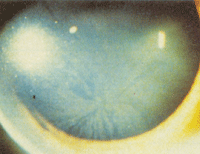 Q: I just saw a patient with a whorled pattern on the corneal epithelium. What is my differential diagnosis?
Q: I just saw a patient with a whorled pattern on the corneal epithelium. What is my differential diagnosis?
A: “First, ask about medications that can cause corneal whorling. These include amiodarone, tamoxifen, chloroquine, indomethacin, meperidine and chlorpromazine,” says Albert M. Morier, M.A., O.D., Associate Clinical Professor of Ophthalmology at Albany Medical College, in Albany, N.Y. Rule out these drugs first because they are the most likely etiology of corneal whorling.
But there’s another etiology you must consider: Fabry disease. Corneal whorling is a telltale sign of this rare, debilitating and eventually fatal lysosomal storage disorder, Dr. Morier says.
Fabry disease causes lipids to accumulate in the various organs of the body. One of the earliest and most common signs are opacities that appear as the characteristic verticillata (a whorl-like pattern of lines) on the cornea. These whorls are thin, located at Bowman’s layer and do not affect visual acuity. But, they should not be overlooked just because they seem benign and don’t affect vision.
Other ocular signs include tortuosity of blood vessels in both the conjunctiva and the retina, and two types of cataracts that are associated with the disease: a “propeller cataract” that radiates from the periphery of the lens and a “Fabry cataract,” which is a faint, thin, linear cataract (best seen by retro-illumination).
Systemic signs and symptoms include a history of not perspiring (anhidrosis), gastrointestinal distress (such as explosive, spontaneous diarrhea and cramps), extreme pain in hands and feet at certain times of year (acroparesthesia) and telangiectatic cutaneous lesions (angiokeratomas).

Corneal whorling suggests Fabry disease. Photo: Genzyme Corp.
As the patient ages and the disease progresses, the accumulation of lipids within the body eventually leads to kidney disease and necrosis, thickening of the left ventrical wall of the heart, transient ischemic attack and stroke. Although this is a sex-linked disease, females can demonstrate some if not all of the characteristics of the disease as males.
Unfortunately, the disease is often misdiagnosed at first because of the nonspecific initial symptoms. For instance, a child who presents to the pediatrician with acroparesthesia is often dismissed as having growing pains, Dr. Morier says.
“However, optometrists can use the ocular signs to get on the right track to considering Fabry’s disease,” he says. “Optometry is without question the profession in the most crucial position to find Fabry at an early stage.”
Corneal verticillata can show up in a first-grader’s first eye exam, for example.
“It’s apparent that the sooner that you can stop the accumulation of lipids in different parts of the body, the less damage can occur,” he says. “So, a timely referral to a geneticist or a metabolic specialist is very important.”
Such a specialist can start the patient on the only approved treatment—enzyme replacement therapy—to limit and hopefully reverse the damage of accumulated lipids in the organs.
However, if you must send the patient to his or her primary care physician, be dutiful and write a letter, Dr. Morier says. “Because of the rarity of the disease, the PCP may not give your diagnosis due consideration unless it’s entered into the medical record as a letter.”
An additional warning for optometrists: If you see a patient who is on amiodarone and has corneal whorling, don’t assume that the amiodarone is causing it. The patient could still have Fabry disease. “Yes, amiodarone does cause corneal whorling, but amiodarone is an antiarrhythmic that may be prescribed to treat Fabry disease,” Dr. Morier says.
In short, “We have a chance to save people’s lives and increase their quality of life,” he says.

